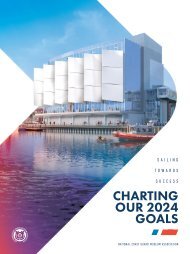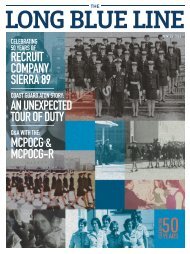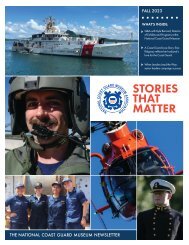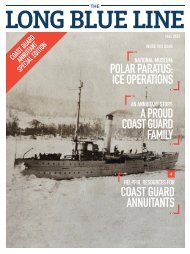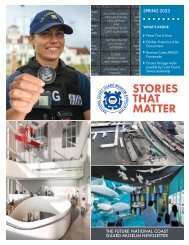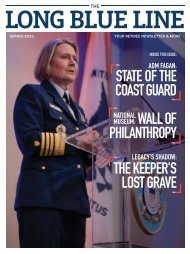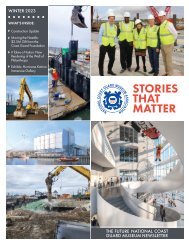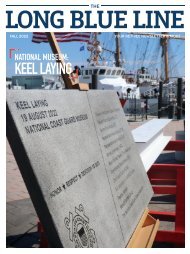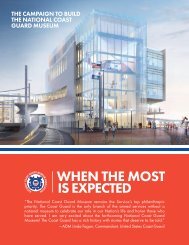NCGMA Newsletter 2023 (Summer)
Catch up on all the recent updates and construction progress for the National Coast Guard Museum.
Catch up on all the recent updates and construction progress for the National Coast Guard Museum.
You also want an ePaper? Increase the reach of your titles
YUMPU automatically turns print PDFs into web optimized ePapers that Google loves.
Upper Left: There are no known images of the Revenue Cutter<br />
Argus. This image is a sloop in New York Harbor circa 1880. The<br />
Argus was most likely built in a similar fashion. (Hudson River<br />
Maritime Museum archive)<br />
Bottom Left: Burning of New London; oil on canvas painted by<br />
John Trumbull. John Trumbull (June 6, 1756 – November 10,<br />
1843) was an American artist of the early independence period,<br />
notable for his historical paintings of the American Revolutionary<br />
War.<br />
Right: Engraving of Continental Army General Jedediah Huntington<br />
by H. B. Hall.<br />
role in the town’s rebuilding efforts, constructing<br />
vessels to meet the demands of a resurgent<br />
maritime industry—including one of the ships<br />
for the newly formed Revenue-Marine.<br />
At this time, Continental Army General Jedediah<br />
Huntington, a Revolutionary War veteran and<br />
graduate of Harvard University, was serving as<br />
the newly appointed customs collector for New<br />
London—one of the designated cutter seaports.<br />
Huntington was instrumental in overseeing the<br />
construction and outfitting of Connecticut’s<br />
assigned cutter, which would be named<br />
Argus. The vessel was a sloop, a one-masted<br />
sailboat with a fore-and-aft mainsail and a<br />
jib. He contracted a local shipbuilding family<br />
and worked closely with the commissioned<br />
ship captain, Jonathan Maltbie, a Continental<br />
Navy veteran and respected mariner. Once<br />
the vessel’s construction was completed in New<br />
London, the cutter was moved several miles<br />
down the shoreline to the town known today<br />
as Niantic, where it was rigged and outfitted at<br />
Beckwith’s boatyard in Keeney Cove. The vessel<br />
began patrolling Connecticut and Rhode Island<br />
waters in October 1791.<br />
When not at sail, the Argus split its time<br />
between its mooring in New London’s harbor<br />
and a station in New Haven. Living up to the<br />
region’s shipbuilding reputation, Argus proved<br />
to be crafted of the highest quality methods and<br />
materials. The longest-lasting of the original 10<br />
cutters, the Argus served an outstanding 13<br />
years of service—a testament to its superior<br />
construction.<br />
During its life in service, the Argus played a<br />
crucial role in enforcing Alexander Hamilton’s<br />
vision of maritime law. Although few substantial<br />
records survive concerning any of the first 10<br />
cutters’ activities, various accounts indicate that<br />
these vessels most likely served a wide variety<br />
of needs, including boarding incoming and<br />
outgoing vessels, ensuring that all cargoes were<br />
properly documented, sealing cargo holds of<br />
incoming vessels, and seizing vessels that were<br />
in violation of the law. The Revenue-Marine also<br />
took on the responsibility of aiding and assisting<br />
troubled vessels and, in 1832, revenue cutters<br />
were ordered to conduct winter cruises to assist<br />
mariners in need. In 1837, Congress codified<br />
this practice as an official part of its regulations.<br />
The Revenue Cutter Argus Promenade at the<br />
National Coast Guard Museum will serve as<br />
a gateway for museum patrons, residents, and<br />
visitors to the city to explore more than two<br />
centuries of maritime and Coast Guard history.<br />
Every view from the Promenade brings to life<br />
the history of this important harbor and illustrates<br />
its maritime relevance today. Looking a short<br />
distance south from the Promenade is where the<br />
Argus was once likely stationed. In the same<br />
vicinity along City Pier, the USCGC Barque<br />
Eagle, the Nation’s only remaining active military<br />
sailing training vessel will soon be homeported.<br />
Further along the Thames River waterfront, a<br />
stunning reproduction of the historic early 19th<br />
century top-sail schooner La Amistad is docked.<br />
Facing inland from the Promenade, buildings<br />
predating the Revolutionary War stand as<br />
beacons of the town’s historical significance, its<br />
cultural heritage, and architectural importance.<br />
Across the river, it is easy to see that the<br />
shipbuilding industry remains robust. Today, the<br />
ships being built are no longer wooden sloops<br />
or schooners, but state-of-the-art submarines at<br />
the General Dynamics Electric Boat shipyard.<br />
Indeed, the Argus Promenade is the heart of<br />
maritime history in all directions!<br />
SUMMER <strong>2023</strong><br />
PAGE 9





